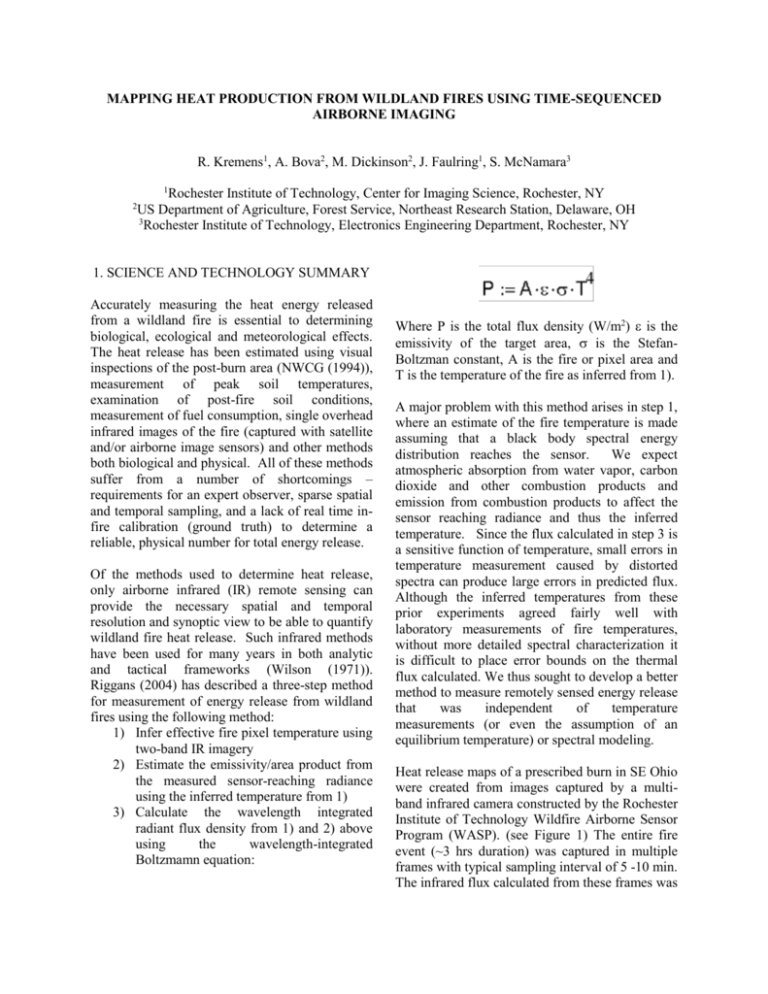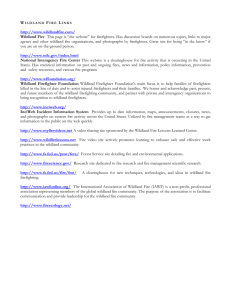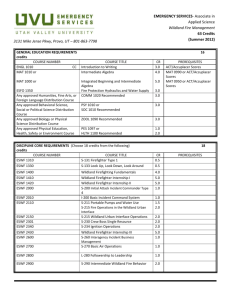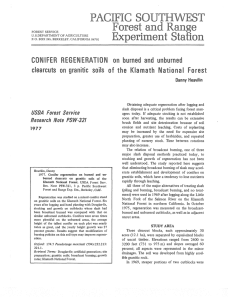Mapping unburned areas using time
advertisement

MAPPING HEAT PRODUCTION FROM WILDLAND FIRES USING TIME-SEQUENCED AIRBORNE IMAGING R. Kremens1, A. Bova2, M. Dickinson2, J. Faulring1, S. McNamara3 1 Rochester Institute of Technology, Center for Imaging Science, Rochester, NY US Department of Agriculture, Forest Service, Northeast Research Station, Delaware, OH 3 Rochester Institute of Technology, Electronics Engineering Department, Rochester, NY 2 1. SCIENCE AND TECHNOLOGY SUMMARY Accurately measuring the heat energy released from a wildland fire is essential to determining biological, ecological and meteorological effects. The heat release has been estimated using visual inspections of the post-burn area (NWCG (1994)), measurement of peak soil temperatures, examination of post-fire soil conditions, measurement of fuel consumption, single overhead infrared images of the fire (captured with satellite and/or airborne image sensors) and other methods both biological and physical. All of these methods suffer from a number of shortcomings – requirements for an expert observer, sparse spatial and temporal sampling, and a lack of real time infire calibration (ground truth) to determine a reliable, physical number for total energy release. Of the methods used to determine heat release, only airborne infrared (IR) remote sensing can provide the necessary spatial and temporal resolution and synoptic view to be able to quantify wildland fire heat release. Such infrared methods have been used for many years in both analytic and tactical frameworks (Wilson (1971)). Riggans (2004) has described a three-step method for measurement of energy release from wildland fires using the following method: 1) Infer effective fire pixel temperature using two-band IR imagery 2) Estimate the emissivity/area product from the measured sensor-reaching radiance using the inferred temperature from 1) 3) Calculate the wavelength integrated radiant flux density from 1) and 2) above using the wavelength-integrated Boltzmamn equation: Where P is the total flux density (W/m2) is the emissivity of the target area, is the StefanBoltzman constant, A is the fire or pixel area and T is the temperature of the fire as inferred from 1). A major problem with this method arises in step 1, where an estimate of the fire temperature is made assuming that a black body spectral energy distribution reaches the sensor. We expect atmospheric absorption from water vapor, carbon dioxide and other combustion products and emission from combustion products to affect the sensor reaching radiance and thus the inferred temperature. Since the flux calculated in step 3 is a sensitive function of temperature, small errors in temperature measurement caused by distorted spectra can produce large errors in predicted flux. Although the inferred temperatures from these prior experiments agreed fairly well with laboratory measurements of fire temperatures, without more detailed spectral characterization it is difficult to place error bounds on the thermal flux calculated. We thus sought to develop a better method to measure remotely sensed energy release that was independent of temperature measurements (or even the assumption of an equilibrium temperature) or spectral modeling. Heat release maps of a prescribed burn in SE Ohio were created from images captured by a multiband infrared camera constructed by the Rochester Institute of Technology Wildfire Airborne Sensor Program (WASP). (see Figure 1) The entire fire event (~3 hrs duration) was captured in multiple frames with typical sampling interval of 5 -10 min. The infrared flux calculated from these frames was time-integrated, producing a map of total heat release, and calibrated using several ground-based infrared sensors in the fireground that measured thermal flux emitted from the surface. As the particular sampling interval (~ 300 seconds) gives a discontinuous description of fire behavior with insufficient time resolution to observe dynamic fire effects and cannot provide exact heat output for all points within the burned area, we have developed an extrapolation method that obtains an upper limit and lower limit to the released thermal energy based on the available imagery, temporal sampling rates and observed thermal decay rates. The basic method for construction of a heat map is as follows; 1) Capture a time series of airborne IR images (using the WASP imager). 2) Simultaneously capture time-resolved ground calibration data and burn plot samples (pre- and post- fire). 3) Use the ground calibration data to absolutely calibrate the image and remove the effects of atmospheric propagation. This method is similar to a ground truth based calibration method described in Schott (1995). 4) Geo- and ortho-rectify images and create single-frame mosaics for each time interval. 5) For each pixel in the mosaic image, obtain a cooling rate for that pixel by observing the flux difference between successive frames after the passage of a fire front. 6) Time integrate the images from 4) to produce the total energy release map: where L = total energy leaving a pixel, Dn = digital data value from the image, t = time interval between frames, C = calibration derived from ground sensors, f = frame number, n = total number of frames. This process is repeated for all pixels. Since there are a limited number of ground sensors, we use the calibration value C derived from the ground sensor closest to the pixel in the summation. This gives the lower bound for the energy emitted from the fire for each pixel. 7) For each frame in the time sequence image, extrapolate the energy flux back in time using the cooling rate calculated in 5). 8) Time integrate the images from 7) using the technique described in 6). This is the upper bound for the heat release from the fire. We compare the heat release map produced with this method to more than 40 ground-sample stations in an effort to predict fuel consumption and other fire effects parameters. There was excellent agreement between fuel burn up (weight of fuel in a sample plot before and after passage of the fire front) and the energy release map generated by this method. For the case of no energy released (fuel unburned), Table 1 shows the agreement for 9 sample plots between our energy release map and ground sampling. Figure 2 shows an expanded image detail of two of the 9 unburned sample plots. As this method uses ground sampling to calibrate the overhead imagery, the upwelled flux from the scene, which could include significant energy released by hot gases above the fire, is ignored. This method therefore is best suited to smaller fires with low energy contained in the smoke and gas plume. Future experiments will include an upwelled fluence sensor to measure the upwelled radiance and eliminate this shortcoming. Figure 1 - A thermal flux map for a prescribed fire in Vinton Furnace, Ohio. This map was prepared from 11 time-sequenced frames using the technique described in the text. Sample Plot Name S1 S2 N5 N6 N9 N10 N12 R1 T15 Energy release from image 0 (unburned) 0 (unburned) 0 (unburned) 0 (unburned) 0 (unburned) 0 (unburned) 0 (unburned) 0 (unburned) 0 (unburned) Table 1 - Comparison of heat release as calculated by the method described in the test and ground truth. All these samples were unburned as determined by ground truth physical examinations. been obtained with conventional field survey methods for 40 plots in a 40 hectare in a prescribed fire. This work has been performed under NASA contract NAG13-02051, and with support from the National Fire Plan, whose support is greatly appreciated. 3. BIBLIOGRAPHY Kremens, R.; Faulring, J.; Gallagher, A.; Seema, A.; Vodacek, A. 2003a. Autonomous fielddeployable wildland fire sensors. Int. J. of Wildland Fire. (12): 237-244 Kremens, R.; Faulring, J.; Hardy, C. 2003b. Measurement of the time-temperature and emissivity history of the burn scar for remote sensing applications. 2nd International Wildland Fire Ecology and Fire Management Congress, 1620 November, Orlando FL. American Meteorological Society National Wildfire Coordinating Group (NWCG), 1994: Fire Effects Guide. NFES 2394. Figure 2 - Sub-images from the energy release map showing unburned areas around two groundsampled plots. These areas had no fuel consumption and no visible fire effects during post-fire ground truth examinations. 2. CONCLUSIONS We have developed a method of measuring radiant energy release from wildland fires that is independent of atmospheric conditions, assumptions about equilibrium and thermal properties of the fire, and models relating temperature to total energy flux. This method gives a lower and upper bound for fire energy release. We are extending this method to include energy released in the upwelled column above each pixel, more ground calibration stations and better modeling of the energy decay rate after the passage of a fire front. Excellent agreement has Riggans, P.J., Tissel, R.G., Lockwood, R. N., Brass, J.A., Perreira, J.A.R., Miranda, H.S., Miranda, A.C. 2004: Remote measurement of energy and carbon flux from wildfires in Brazil. Eco. Appl. 14(3) 855-872. Schott, J.A. (1995) Remote Sensing, An Image Chain Approach. Springer Publishing. Wilson, R.A., Hirsch, S.N., Madden F.H., Losensky, B.J., 1971: Airborne infrared forest fire detection system: final report. USDA Forest Research Paper, INT-93. 4. THE AUTHOR Robert Kremens has been employed by the Rochester Institute of Technology (RIT) at the Center for Imaging Science since 2000. At RIT he has specialized in physical measurements of wildland fires for remote sensing and fire behavior purposes and in constructing new airborne and ground based systems to monitor the environment and wildland fire. Dr. Kremens received his B.S. (1975) in physics form the Cooper Union, M.S. and Ph.D. in physics from New York University, (1981) and a M.S. in environmental studies from the University of Rochester (2000). Before RIT, Dr. Kremens worked at the University of Rochester on the world’s largest pulsed laser, building and analyzing nuclear and laser diagnostics on an inertial fusion experiment, at the United States Army Ballistics Research Laboratory in Aberdeen MD, and at several industrial positions where he designed and constructed high speed data acquisition and imaging systems.







